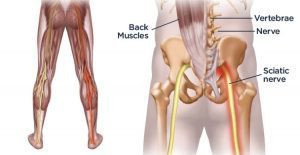The human nervous system is an amazing highway of communication, with approximately 72 kilometres of nerves transmitting signals throughout the body at 360 km/hr. It’s our body’s primary communication system, taking in information through our senses, processing the information and triggering reactions such as muscle movement or feeling pain.
The sciatic nerve is the largest nerve in this vast and complex system running from the lower back and down the back of each leg into the feet. When this becomes inflamed or compressed, it can be a painful and debilitating condition. In some cases, sciatic nerve pain can be so excruciating that you don’t even want to get off the couch.

What is Sciatica?
Sciatic nerve pain refers to a spectrum of pain symptoms that emanate along the path of the sciatic nerve. Typically, this pain originates in the lower back and runs through the buttock area down into the lower limbs.
Causes of Sciatic Nerve Pain
Sciatic nerve pain arises when the sciatic nerve is inflamed, pinched or compressed in the lower back. This can happen for many reasons, some of which are:
- Herniated Disc
The most common cause is a herniated disc in the lower spine. Discs act as shock absorbers or cushioning pads between each vertebra of the spine. A herniated disc occurs when the cartilage on the outside of the disc thins or a tear occurs. When this happens, the discs jelly centre pushes through the tear, putting pressure on the sciatic nerve.
- Spinal Stenosis
Spinal stenosis, which refers to a narrowing of the spaces where the spinal cord/nerves travel down, can also put pressure on the sciatic nerve.
- Spondylolisthesis
The degenerative disk disorder, spondylolisthesis, is where a vertebra moves forwards over another, this will often irritate the nerve below causing sciatic nerve pain.
- Piriformis Syndrome
Piriformis syndrome, the involuntary tightening and contacting of the piriformis muscle (a small muscle that lies deep in the buttocks) can in some cases also compress the sciatica nerve.
- Pregnancy
Compression of the sciatic nerve can also occur during pregnancy, due to the changes associated as the baby grows.
Signs & Symptoms
Sciatica’s trademark symptom is pain running down one side of the lower body from the lower back down through the buttock, thigh, and knee; at times, the pain may spread into the feet and toes. The symptoms can occur bilaterally, although this is not as common. The pain is often described as a sharp, burning sensation or a tingling/numbness radiating down the leg. Sciatica can be present with and without any lower back pain, and will often impede one’s ability to bear weight.
Assessment & Treatment
Early diagnosis through physical testing will help determine the causes of nerve pain sciatica often without the need for radiological imaging. This early diagnosis will target the direction treatment needs to take. While bed rest may help the acute symptoms settle, early mobilisation and exercise is key to reducing the symptoms of sciatica.
In chronic cases, pain management specialists can assist with relieving sciatica pain. Exercising with sciatica is crucial for the best recovery process. Physiotherapy is essential in these cases, in both the rehab and recovery phase to improve back mobility and strength. Core strengthening and flexibility exercises will also reduce pain recurrence.
Prognosis
If diagnosed early, the prognosis for nerve pain sciatica can be very positive (6-12 weeks) and help prevent sciatica episodes. Conditioning exercises such as pilates, core strengthening, and a specific stretching program can reduce the risk and prevent further aggravation. Severe cases can take over 3-6 months to rehabilitate fully.
If you need help with sciatic pain or struggling to get moving, book in for treatment now with one of our exercise physiologists or physiotherapists via 1300 012 273

